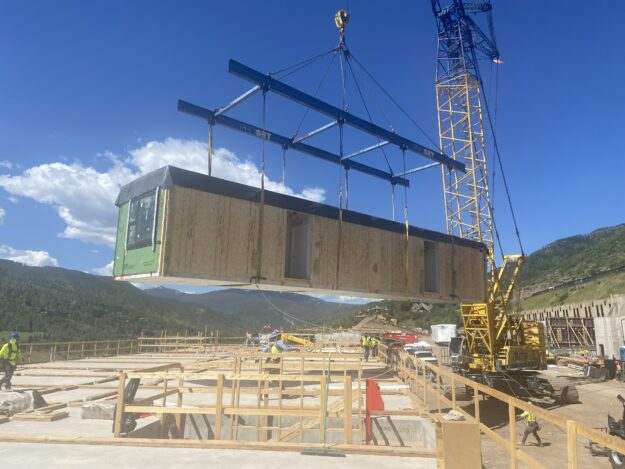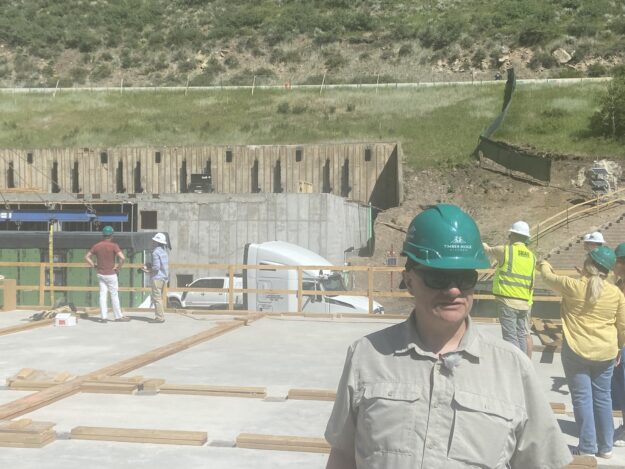Widgetized Section
Go to Admin » Appearance » Widgets » and move Gabfire Widget: Social into that MastheadOverlay zone
First ever Habitat for Humanity homes craned into Vail as ski town tries to tackle acute housing crisis

A modular home is craned into place at Vail’s Timber Ridge redevelopment project on June 30 (David O. Williams photo).
When Doug Alexandre moved here in 2009 to work as a lift mechanic on Vail Mountain, he never thought he’d be able to afford to buy a home in this world-famous ski town where the median home price is more than $2 million.
“I never expected to be a homeowner in the Vail Valley,” Alexandre said on June 30 as modular homes built offsite were being craned into position as part of the town’s new Timber Ridge Village redevelopment project, where Alexandre was selected as one of 20 Habitat for Humanity homeowners.
“It’s the stability. It’s hard to live in a place where you don’t know really month to month if you’re going to have to move out because the owner sold or they decided to Airbnb or whatever it may be,” Alexandre said. “I’ve been in my neighborhood for over 15 years now, and it’s still so transient. It’s really cool to be living with people who are homeowners, maybe even first-time homeowners like myself, that get to stay here in a place that they love.”
Alexandre lived for one season in the town’s rundown, decades-old Timber Ridge housing along Interstate 70 before renting elsewhere for 15 years. That 90-unit, dilapidated but in-demand complex was torn down and is being replaced by 302 new, for-sale modular units ranging from studios to four bedrooms. Modulars are built elsewhere at much lower construction costs.
There are no appreciation caps on the deed-restricted condominiums, but the town requires that each home be occupied by at least one full-time employee of an Eagle County business as their primary residence – either the homeowner or a renter.
The town put up more than $50 million in land and infrastructure costs for the project and is partnering with Triumph Development West. To date, 32 local businesses have bought units, and nearly 100 local residents and workers are also under contract to buy homes at prices ranging between 23% and 34% below comparable recent condo sales. The entire project is already about 75% sold, and the first residents will move in in December.
The 302 new Timber Ridge units, including the 20 Habitat homes, range in price from just over $400,000 for a studio to just over $1 million for a four-bedroom unit.
The non-profit Habitat for Humanity Vail Valley in the 1990s had yet to build any homes in Eagle County. Since then, it’s built 137 homes locally – mostly “down valley” in Gypsum and Eagle – and now it’s self-financing 10 three-bedroom homes at Timber Ridge Village for purchase by qualified buyers. The town and Eagle County, who will act as buy-down partners, helped fill the funding gap between the actual cost to build the homes and affordability.
“We’re obviously so excited to be able to offer opportunities for affordable home ownership up and down the valley, from as far west as Gypsum all the way to Vail,” said Elyse Howard, the Vail Valley Habitat chapter’s Vice President of Community Affairs and Philanthropy. “We are celebrating our 30th anniversary this year and have built 146 homes now.”
That includes nine in Leadville, which is in neighboring Lake County, where the Vail Valley chapter first started in the 1990s and land and construction prices are much lower than Vail.
“What we have learned over the years is that in order to continue to increase our housing production and support our community, we’ve had to come up with a variety of methods to deliver affordable homeownership,” Howard added. “So, we have our traditional stick building model, which is like the [Habitat founder] Jimmy Carter thing that people think about, and then a $2 million investment each by both the town and county will allow Habitat to issue zero-interest mortgages affordable to qualified buyers earning under 80% of the area median income.”
Alexandre, who called the six-hour Habitat application process “ridiculously easy,” said he would not be living in Vail without the program.
“Being chosen to be able to move in here is really a dream come true,” Alexandre said. “As a lift mechanic, I never thought I could live in Vail proper, or even down-valley. And most of the people I work with live in Leadville. They live in Gypsum and Eagle. Very few people live here, and if they do, they bought here years ago, decades ago.”
Even though his new home will be modular, built elsewhere and craned into place, Alexandre will be required to work for Habitat.
“So, all of the Timber Ridge [Habitat] homeowners will do 250 hours of sweat equity per adult,” Howard said. “That hasn’t changed; and it’s something our board is super-committed to.”
Owners of the new modular units will be able to work on traditional, “stick-build” Habitat homes (think former President Carter swinging a hammer into his 90s) that are currently going up at Stratton Flats in Gypsum, another upcoming project partnering with the Eagle County School District, or at the Habitat ReStore in Gypsum.

Doug Alexandre talks to reporters June 30 at Timber Ridge in Vail (David O. Williams photo).
What it means for the ski town
Vail Mayor Travis Coggin, who grew up in Vail and attended the local elementary school – Vail’s only public school — said the town’s push to provide more affordable housing for local workers is about maintaining a sense of community in a place that’s been hollowed out by second-home ownership and short-term rentals. Besides public service, Coggin now works in real estate planning and development and is a part-time member of Vail Ski Patrol.
“Oh yeah, [affordable housing] shifts who’s going to be on our boards and commissions, it shifts who can volunteer, it shifts kids and who’s here,” Coggin said. “It’s great that Red Sandstone [Elementary] has kids that come from Edwards, but it’s really great when those kids live in Vail.”
Second homeowners who live most of the year somewhere else and make up the majority of Vail homeowners want the town to work well when they’re visiting their investment, added the mayor whose council tenure has been marked by a huge surge in workforce rental and for-sale, deed-restricted housing. The Vail InDeed program, he said, is on track to add more than 1,000 units of deed-restricted housing by 2027 in a wide variety of ways, including redevelopment.
“You need the people that keep the lights on because when the hotels are full and the second homes are full, they still are looking for the same level of service,” Coggin said. “They need to be able to be safe by having EMS staff and hospital staff and police and fire and chairlifts running and restaurants working.”
And having workers live closer to Vail Mountain is critical because of the frequency with which I-70 shuts down due to accidents involving semis and personal vehicles on Colorado’s increasingly clogged roads. Coggin said the flow or workers slows to a trickle when the highway closes just to the west at Dowd Junction or to the east at Vail Pass.
“So having people who are part of that demographic that’s working, which is what this community will be here at Timber Ridge, it will be 300 homes of working families,” Coggin said. “It’s going to be a game-changer for so many things.”
Bob Armour, a ski instructor who still lives in West Vail and was mayor of Vail in the 1990s, watched modulars being craned into place in awe on Monday. He said housing and parking were the most critical issues back then and remain so today, but he is impressed with recent progress.
“While we tried, we were kind of nibbling around the edges,” Armour admits. “I like to say that we gave recent councils and our housing department the hammer, and they found a nail to pound. And now we’re seeing a lot of hard work come to fruition. The people that are going to live here just will enhance this community, make it more vibrant, and have a place to call home.”
Zach Meyers, general manager of Manor Vail Lodge, said the iconic Vail hotel is buying a three-bedroom, non-Habitat unit at Timber Ridge to add to its six on-site units, likely for one year-round resident and two more seasonal workers.
“It’s everything in an environment like this to be able to provide some seasonal housing in particular, where we have the shoulder seasons and the business levels go up and down,” Meyers said. “We have to have a portion of our staff be seasonal, and so to have a place for them to live [is critical].”
Meyers adds that Manor Vail staff will also continue to volunteer on Habitat projects.
“It’s going to be great for those people that are looking to set themselves up long-term,” Meyers said of the 20 Habitat homes at Timber Ridge. “We’ve helped on a couple of the projects down valley for Habitat; our team has gone out and done that and we love it.”
Editor’s note: This story first appeared in the Colorado Springs Gazette newspaper.
David O. Williams
Latest posts by David O. Williams (see all)
- First ever Habitat for Humanity homes craned into Vail as ski town tries to tackle acute housing crisis - July 9, 2025
- ‘Now we have to look at that’, Colorado AG Weiser says of challenging Trump’s energy emergency - July 8, 2025
- Neguse, Bennet call for halt to BLM emergency rule aimed at increasing Utah oil-train traffic - June 23, 2025


